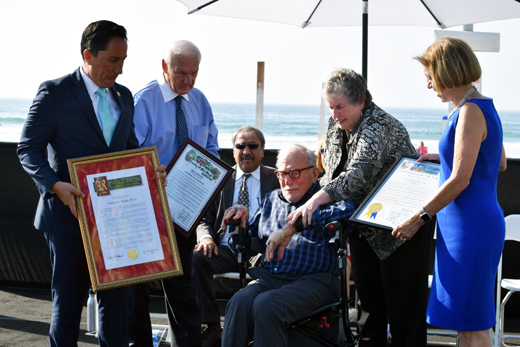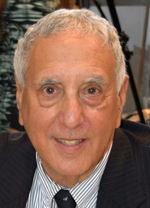
By Donald H. Harrison

SAN DIEGO – It is unsurprising that even two years after his death, Walter Munk, who is known as the “Einstein of the Oceans” is continuing to make waves.
Oceanographer Walter Munk, who died in February 2019 at the age of 101, deeded his beautifully landscaped home, known as “Seiche” to the University of California at San Diego and its Scripps Institution of Oceanography. On April 30, the State of California, with the blessing of Munk’s widow, Mary Coakley Munk, nominated the home for inclusion in the National Register of Historic Places.
However, the daughters of Munk and his late second wife, Judith, who was the designer of the house, say Munk expressed a desire that the home not go on the National Register of Historic Places because he did not want any limitation put on UC San Diego or the Scripps Institution of Oceanography as they decide how to utilize the property. Designation as a historic landmark would result in a requirement that the property, including a house, guesthouse, landscaping, and sculptures be maintained in its current form.
Daughters Kendall and Edie both wrote letters to California’s State Historical Resources Commission in opposition to the designation. Kendall was quoted in the San Diego Union-Tribune as writing that her father “knew that a historical designation could tie the hands of UC/SIO by limiting their options for re-envisioning Seiche, perhaps even forcing them to sell. This would likely drop the value of the house, thus diminishing the monetary support for the specific areas Dad carefully and thoughtfully chose as beneficiaries.” Likewise, Edie wrote “the nomination comes to you in direct opposition to the wishes of my parents who were against (historic designation) in any form.” UC San Diego Chancellor Pradeep K. Khosla agreed with the two daughters’ position.
On the other hand, Munk’s widowed third wife, Mary Coakley Munk, told the La Jolla Light that Munk had changed his mind about not having the property designated as historical because “he wanted to it to remain as much as possible as it was to keep the spirit.” Mary Coakley Munk serves as president of the Walter Munk Foundation for the Oceans.
While no one argued against Munk being considered a “historic figure,” there was debate before the State Historical Resources Board whether the home deserved a historical designation from an architectural standpoint. Built in 1954, additions were made to Seiche in 1961, 1971, and 1985. Historic designations may be made on the basis of original architecture or association with an historic figure, or both.
“Seiche” is defined by the National Ocean Service as a “standing wave oscillating in a body of water.” It is likened to waves going back and forth in a see-saw motion.
It was Munk’s unique understanding of waves that enabled the scientist to predict what days would be most propitious for World War II allies to make their amphibious landings on the beaches of North Africa and later on those of Normandy on D-Day.
A Jewish refugee from Austria, Munk immigrated first to the United States as a student, initially following his parents’ wishes to prepare at Columbia University for a career in banking, but later deciding to study physics at the California Institute of Technology (CalTech). That led to a summer job in 1939 at Scripps Institution of Oceanography, the same year he earned his bachelor’s degree in applied physics. The following year he earned a master’s at Caltech in geophysics with his thesis based upon the work of Harald Sverdrup, a Norwegian oceanographer who then was director of Scripps. Munk persuaded Sverdrup in 1939 to take him on at Scripps as a doctoral student.
However, World War II interrupted Munk’s doctoral studies, but he made a name for himself working with Sverdrup predicting surf conditions. He also formulated ways to interpret sounds moving through the ocean, reportedly giving the United States an edge in submarine warfare over both Germany and Japan, and was instrumental in reading ocean movements to predict tsunamis.
It was not until 1947, two years after the war ended, that Munk formally was awarded his Ph.D. The following year he studied wind-driven ocean circulation, inventing the term “ocean gyre,” which the National Ocean Service defines as “a large system of rotating ocean currents.”
In 2017, when the City of San Diego decided to name a seaside path in La Jolla as “Walter Munk Way” in honor of his 100th birthday, then City Councilwoman Barbara Bry noted that over his career, Munk had furthered human understanding of “ocean currents, tides, deep ocean mixing, wind waves, tsunamis, seismic waves and the earth’s rotation.” Some of his students who discovered pygmy devil rays in the Sea of Cortez honored him by naming the species Mobula munkiana, she noted.
UCSD Chancellor Khosla at that same ceremony told of Dartmouth College’s desire to present Munk with its highest academic honor. He related that Munk shyly said there might be a problem with that: Dartmouth had awarded him the same honor 40 years previously.
At that 2017 ceremony, Munk speculated that “Walter Munk Way” would not survive as long as he had unless the nations of the world cooperate to stave off rising seas. “We need to learn how to convert fossil energy to renewable energy,” Munk advised. A spirit of bipartisanship will be needed among American politicians to accomplish this, and, further, “we need to have good relations with the United Nations and our allies,” he said.
In 2019, on what would have been Munk’s 102nd birthday, surfers gathered in a ring near the Scripps Pier and tossed biodegradable flowers into the ocean in his memory. Serge Dedina, the mayor of Imperial Beach, was among those paying tribute to Munk, telling the Times of San Diego that while the oceanographer was charting tidal action for the Normandy Invasion, “My mother was in London being bombed at the time” and “My father’s family [was] being carted off to concentration camps and being eviscerated by the Nazis. So I always personally thanked Walter for helping to liberate Europe, to make sure our troops were safe and to pay a footnote in … world peace.”
*
Donald H. Harrison is editor of San Diego Jewish World. He may be contacted via donald.harrison@sdjewishworld.com